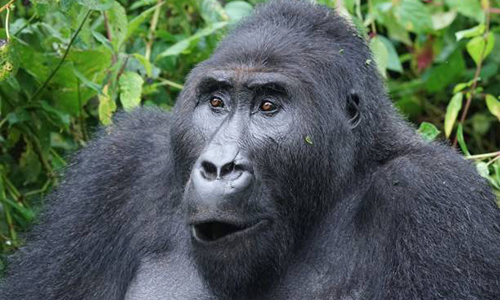Types of Gorillas: Gorilla Species and Sub Species in the World
Types of gorillas in Africa and the world include the Eastern Gorilla and the Western Gorilla. Each type is further divided into two subspecies. These gorilla species and subspecies are found in various locations where gorilla trekking can take place in Africa. With all the types of gorillas, their natural destinations for gorilla sightings or treks are located in East and Central Africa, with additional opportunities to see gorillas in zoos outside the continent.
Gorilla Types and Classifications: Main Species and Sub species:
The eastern gorilla species comprise of the Mountain gorilla (Gorilla beringei beringei) and the Eastern Lowland gorilla also known as Grauer’s gorilla (Gorilla beringei graueri)
The Western Gorilla (Gorilla gorilla) contains the Western Lowland Gorilla (Gorilla gorilla gorilla) and Cross River Gorilla (Gorilla gorilla diehli)
Types of Gorillas, Quick Summary:-
1. Eastern Gorilla (Gorilla beringei)
(a) Mountain Gorilla (Gorilla beringei beringei)
(b) Eastern Lowland Gorilla (Gorilla beringei graueri)
2. Western Gorilla (Gorilla gorilla)
(a) Western Lowland Gorilla (Gorilla gorilla gorilla)
(b) Cross River Gorilla (Gorilla gorilla diehli)
What are gorillas?
Gorillas are herbivorous, largely ground-dwelling great apes that live in the humid woodlands of equatorial Africa. The Deoxyribonucleic Acid (DNA) of gorillas is very much alike to that of human bingss, from 95 to 99% depending on what is included and are next closest living relatives to people after chimpanzees and bonobos.
Gorillas are the biggest primates alive, attaining heights between 1.25 and 1.8 metres, body weights between 100 and 270 kilograms and arm spans up to 2.6 metres, basing on species and sex. They have a tendency of living in troops under the leadership of a silverback. The eastern gorilla is differentiated from the western by darker hair or fur colour and some other minor morphological dissimilarities. Gorillas tend to live between 35 to 40 years in the wild.
The natural habitats of gorillas cover tropical forests in the Sub-Saharan Africa. Even though their range occupy a small segment of Sub-Saharan Africa, gorillas cover a wide range of elevations. The mountain gorilla inhabits the Albertine Rift montane cloud forests of the Virunga Volcanoes, ranging in elevation from 2,200 to 4,300 metres (7,200 to 14,100 feet). Lowland gorillas inhabit the thick jungles and lowland marshlands and swamp lands as low as sea level, with western lowland gorillas existing in Central West African countries and eastern lowland gorillas living in the Democratic Republic of the Congo nearby its national boundary with Rwanda.
It is approximated that there are around 316,000 western gorillas in the wild and 5,000 eastern gorillas. Both gorilla species and types under each are categorized as Endangered by the International Union for Conservation of Nature (IUCN). IUCN) is an global organization working in the area of nature conservation and sustainable use of natural resources. All subspecies are branded as Critically Endangered apart from the mountain gorilla, which is considered as Endangered. There are voluminous dangers to survival of different types of gorillas including poaching, habitat destruction, and disease among others. Though, some conservation campaigns have yielded success in certain areas where they live.
EASTERN GORILLA (GORILLA BERINGEI)
The Eastern Gorilla (Gorilla beringei) is one of two species of gorillas, native to the forests of central Africa. It is divided into two subspecies: the Mountain Gorilla (Gorilla beringei beringei), which inhabits the mountainous regions of Uganda, Rwanda, and the Democratic Republic of Congo, and the Eastern Lowland Gorilla (Gorilla beringei graueri), found in the lowland forests of eastern Democratic Republic of Congo.
Eastern gorillas are large, herbivorous primates, with a predominantly vegetarian diet consisting of leaves, stems, fruit, and bamboo. They are known for their intelligence and complex social structures, living in groups led by a dominant silverback male. Unfortunately, both subspecies are critically endangered, primarily due to habitat loss, poaching, and human-wildlife conflict. Conservation efforts are ongoing to protect these remarkable primates.
Mountain Gorilla (Gorilla beringei beringei)
 The Mountain Gorilla (Gorilla beringei beringei) is a subspecies of the Eastern Gorilla, found in the mountainous forests of central Africa, specifically in the Virunga Mountains, which span the borders of Rwanda, Uganda, and the Democratic Republic of the Congo. These gorillas are characterized by their larger size, thicker fur, and distinct adaptation to colder, high-altitude environments compared to other gorilla subspecies.
The Mountain Gorilla (Gorilla beringei beringei) is a subspecies of the Eastern Gorilla, found in the mountainous forests of central Africa, specifically in the Virunga Mountains, which span the borders of Rwanda, Uganda, and the Democratic Republic of the Congo. These gorillas are characterized by their larger size, thicker fur, and distinct adaptation to colder, high-altitude environments compared to other gorilla subspecies.
Mountain gorillas live in social groups led by a dominant silverback male, and their diet mainly consists of vegetation such as leaves, stems, and fruit. Unfortunately, their population is endangered due to habitat loss, poaching, and disease, although concerted conservation efforts have helped increase their numbers in recent years. They are also a popular subject of eco-tourism, providing significant economic benefits to local communities.
The Eastern Lowland Gorilla (Gorilla beringei graueri)
The Eastern Lowland Gorilla (Gorilla beringei graueri) is a subspecies of the eastern gorilla found primarily in the dense rain forests of the Democratic Republic of the Congo. It is the largest of all gorilla subspecies, with males weighing up to 250 kg (550 lbs) and exhibiting a robust, muscular physique.
These gorillas are primarily herbivores, feeding on a diet that includes leaves, stems, fruits, and bamboo shoots. They live in small, tight-knit family groups led by a dominant silverback male. The Eastern Lowland Gorilla is critically endangered due to habitat loss, poaching, and civil unrest in the region. Conservation efforts are ongoing to protect their natural habitat and mitigate the threats to their survival.
WESTERN GORILLA (GORILLA GORILLA)
The Western Gorilla (Gorilla gorilla) is one of two species of gorillas, native to the forests of central and western Africa. It is divided into two subspecies: the Western Lowland Gorilla (G. g. gorilla) and the Cross River Gorilla (G. g. diehli). Western gorillas are generally smaller and more agile than their Eastern counterparts, with males exhibiting prominent silverback hair as they mature. They are primarily herbivorous, feeding on a diet of fruits, leaves, and stems. They live in social groups led by a dominant silverback, who protects the group and makes decisions. These gorillas are critically endangered, with habitat destruction, poaching, and disease being significant threats to their survival. Despite their strength, they are generally peaceful and gentle creatures.
Western Lowland Gorilla (Gorilla gorilla gorilla)
The Western Lowland Gorilla (Gorilla gorilla gorilla) is a subspecies of the eastern gorilla and the most widespread of all gorilla subspecies. Native to the dense tropical forests of central and West Africa, they are typically found in countries such as Cameroon, the Central African Republic, the Republic of Congo, Gabon, and Equatorial Guinea. These gorillas are generally herbivores, feeding on a diet of fruits, leaves, stems, and bark.
Western Lowland Gorillas are characterized by their large, robust build, dark fur, and gentle temperament, though they can be formidable when threatened. They live in groups led by a dominant silverback male, with females and young forming the rest of the group. These gorillas are critically endangered due to habitat destruction, poaching, and disease, particularly the Ebola virus. Conservation efforts are crucial for their survival in the wild.
Cross River Gorilla (Gorilla gorilla diehli)
The Cross River Gorilla (Gorilla gorilla diehli) is a critically endangered subspecies of the western gorilla, found primarily in the dense forests along the border between Nigeria and Cameroon. It is the most elusive and rarest of the gorilla subspecies, with an estimated population of fewer than 300 individuals in the wild. These gorillas inhabit steep, rugged terrain, making them difficult to study and protect. The Cross River Gorilla is characterized by its smaller size compared to other gorillas, with a distinct physical appearance featuring a slightly shorter face and smaller body. They live in groups led by a dominant silverback male and primarily feed on a diet of leaves, fruits, and stems. Habitat destruction, poaching, and human encroachment have all contributed to their dwindling numbers, making conservation efforts essential for their survival.

 The Mountain Gorilla (Gorilla beringei beringei) is a subspecies of the Eastern Gorilla, found in the mountainous forests of central Africa, specifically in the Virunga Mountains, which span the borders of Rwanda, Uganda, and the Democratic Republic of the Congo. These gorillas are characterized by their larger size, thicker fur, and distinct adaptation to colder, high-altitude environments compared to other gorilla subspecies.
The Mountain Gorilla (Gorilla beringei beringei) is a subspecies of the Eastern Gorilla, found in the mountainous forests of central Africa, specifically in the Virunga Mountains, which span the borders of Rwanda, Uganda, and the Democratic Republic of the Congo. These gorillas are characterized by their larger size, thicker fur, and distinct adaptation to colder, high-altitude environments compared to other gorilla subspecies.